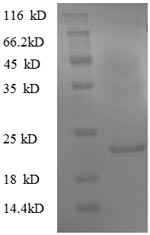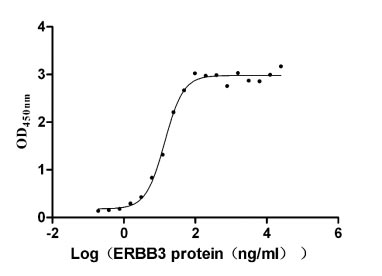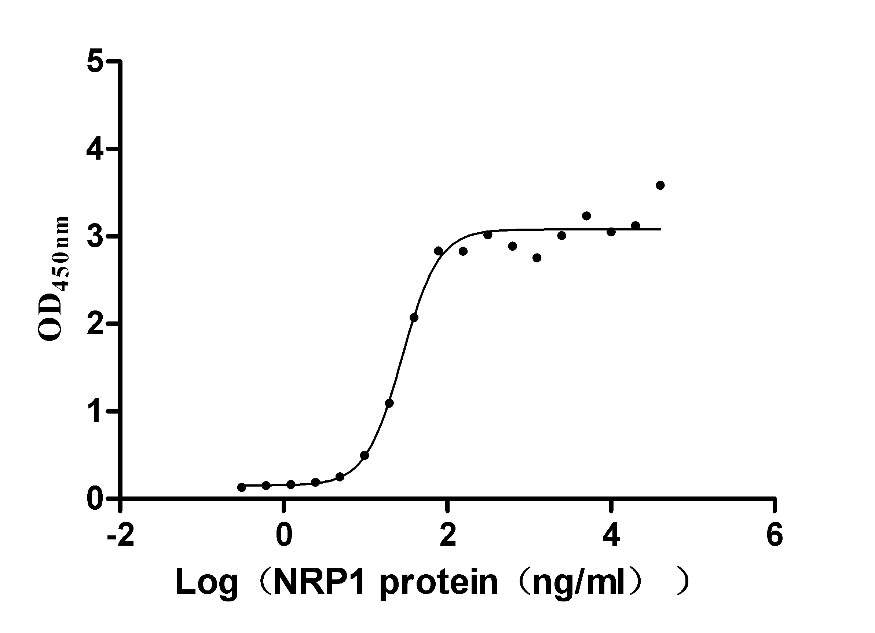Recombinant Mouse Translationally-controlled tumor protein (Tpt1)
In Stock-
中文名称:小鼠Tpt1重组蛋白
-
货号:CSB-EP024134MO
-
规格:¥1836
-
图片:
-
其他:
产品详情
-
纯度:Greater than 90% as determined by SDS-PAGE.
-
基因名:Tpt1
-
Uniprot No.:
-
别名:Tpt1; Trt; Translationally-controlled tumor protein; TCTP; 21 kDa polypeptide; p21; p23
-
种属:Mus musculus (Mouse)
-
蛋白长度:Full Length
-
来源:E.coli
-
分子量:23.5kDa
-
表达区域:1-172aa
-
氨基酸序列MIIYRDLISHDELFSDIYKIREIADGLCLEVEGKMVSRTEGAIDDSLIGGNASAEGPEGEGTESTVVTGVDIVMNHHLQETSFTKEAYKKYIKDYMKSLKGKLEEQKPERVKPFMTGAAEQIKHILANFNNYQFFIGENMNPDGMVALLDYREDGVTPFMIFFKDGLEMEKC
Note: The complete sequence including tag sequence, target protein sequence and linker sequence could be provided upon request. -
蛋白标签:N-terminal 6xHis-tagged
-
产品提供形式:Liquid or Lyophilized powder
Note: We will preferentially ship the format that we have in stock, however, if you have any special requirement for the format, please remark your requirement when placing the order, we will prepare according to your demand. -
缓冲液:Tris-based buffer,50% glycerol
-
储存条件:Store at -20°C/-80°C upon receipt, aliquoting is necessary for mutiple use. Avoid repeated freeze-thaw cycles.
-
保质期:The shelf life is related to many factors, storage state, buffer ingredients, storage temperature and the stability of the protein itself.
Generally, the shelf life of liquid form is 6 months at -20°C/-80°C. The shelf life of lyophilized form is 12 months at -20°C/-80°C. -
货期:3-7 business days
-
注意事项:Repeated freezing and thawing is not recommended. Store working aliquots at 4°C for up to one week.
-
Datasheet & COA:Please contact us to get it.
相关产品
靶点详情
-
功能:Involved in calcium binding and microtubule stabilization.
-
基因功能参考文献:
- The biological effects of Na,K-ATPase and TCTP interaction are reviewed. PMID: 29867020
- that TPT1 knockdown altered the BECN1 interactome, a representative MTOR-independent pathway, to stimulate autophagosome formation PMID: 28409693
- The first crystal structure of murine HRF to 4.0A resolution, reveals a conserved fold. A model for the role of murine HRF in mast cell activation was created based on the human HRF structure. PMID: 29216544
- Fortilin directly interacts with the cytoplasmic domain of IRE1alpha, inhibits both kinase and endoribonuclease (RNase) activities of this stress sensor, and protects cells against apoptotic cell death at both cellular and whole animal levels. PMID: 28550308
- TCTP-mediated spindle dynamics play a key role in maintaining oocyte quality during postovulatory aging. Overexpression of TCTP is sufficient to prevent aging-associated abnormalities in mouse oocytes. PMID: 28476647
- Leads to the enhanced and previously un-described interaction of RACK1 and TCTP. PMID: 27816562
- These data suggest the presence of a novel oxidative-stress-handling pathway where the anti-p53 molecule fortilin augments the peroxidase PRX1 by protecting it against degradation and inactivation of the enzyme. PMID: 26726832
- results demonstrate that TCTP is a microtubule-associating protein required to regulate spindle microtubule dynamics during meiotic maturation in mouse oocytes. PMID: 26802898
- TCTP over-expression-induced RhoA activation indicates that silencing of cellular TCTP may offer therapeutic approaches for the regulation of hypertension by inhibiting RhoA/Rho kinase pathway and modulating vascular contractility. PMID: 24918292
- osteoclastogenic activity of translationally-controlled tumor protein (TCTP) with reciprocal repression of p21 PMID: 25263704
- Fortilin, induced in the proatherosclerotic microenvironment in macrophages, protects macrophages against Bax-induced apoptosis, allows them to propagate, and accelerates atherosclerosis. PMID: 24043250
- Overexpression of translationally controlled tumor protein increases the severity of atherosclerosis and hypertension in apolipoprotein E knock-out mice PMID: 22415346
- These findings suggest that TCTP might play an important role in the process of podocyte hypertrophy under diabetic conditions via the regulation of mTORC1 activity and the induction of cell-cycle arrest. PMID: 22311416
- The TCTP downregulates the Oct4 expression by binding the Sf1 site of Oct4 promoter in mouse pluripotent cells. PMID: 22281008
- TCTP may play a significant role in embryo implantation in mice PMID: 21865235
- knockdown of Tctp resulted in increased amounts of P53 accompanied by a 50% reduction in the efficiency of tumor mammosphere formation PMID: 22157679
- Identified a subset of IgE and IgG antibodies as TCTP(HRF)-interacting molecules in vitro. HRF was able to dimerize and bind to Igs via interactions of its N-terminal and internal regions with the Fab region of Igs. PMID: 22133880
- Data indicate that Hprt, Rpl13a and Tpt1 are a set of stably expressed reference genes for accurate gene expression normalization in myocardial infarction studies in mice. PMID: 21858224
- The Tpt1-Npm1 complex as a novel marker for highly proliferating cells, and offer further insight into the network that controls cellular fate. PMID: 20505363
- Results imply that TCTP levels influence the sensitivity of beta cells to apoptosis PMID: 21063673
- TCTP levels influence sensitivity to apoptosis PMID: 19901967
- Plk phosphorylates TCTP on 2 Ser residues in vitro & cofractionates with the majority of kinase activity toward TCTP in mitotic cell lysates. Phosphorylation decreases its microtubule-stabilizing activity & promotes increased MT dynamics after metaphase. PMID: 12167714
- seven putative Tpt1 genes with different chromosomal localizations were identified; analysis of sequence, genomic organization, and in vitro promoter activity. PMID: 12782126
- TCTP stabilizes Mcl-1 through interfering with Mcl-1's degradation by the ubiquitin-dependent proteasome degradation pathway and modulates its antiapoptotic activity. PMID: 15798198
- an N-terminal region of a cytosolic protein, TCTP, is required for its binding to Bcl-xL and for its antiapoptotic activity PMID: 15870695
- These results suggest that despite that TCTP is widely expressed in many tissues or cell types, it appears to regulate cell proliferation and survival in a tissue- or cell type-specific manner. PMID: 17475776
- Fortilin is an intracellular Ca2+ scavenger, protecting cells against Ca2+-dependent apoptosis by binding and sequestering divalent calcium ions (Ca2+) from the downstream Ca2+-dependent apoptotic pathways. PMID: 17705784
- TCTP antisense expression in CD25(high) regulatory T cells aggravates cuff-injured vascular inflammation PMID: 18789801
- In early phase of development, fortilin functions as an inhibitor of the bone morphogenetic protein pathway. PMID: 19364479
- Study demonstrated that TCTP acts as a cataractogenic factor through the repression of Na,K-ATPase activity and calcium mobilization in lens epithelial cells. PMID: 19479337
- Proton pump inhibitors exert anti-allergic effects by reducing TCTP secretion PMID: 19484128
- TCTP plays a very modest role in thymocyte development, but is critical for peripheral T cell maintenance and T cell receptor (TCR)-mediated cell proliferation. PMID: 19605695
收起更多
-
亚细胞定位:Cytoplasm.
-
蛋白家族:TCTP family
-
数据库链接:
KEGG: mmu:22070
STRING: 10090.ENSMUSP00000106519
UniGene: Mm.297482





















